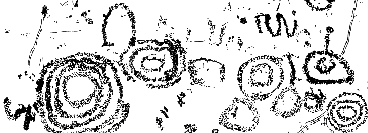

All narrative begins in sound. It is the sensual glue that binds our thoughts to the material and immaterial world. It is the sound of civilization and the creative act. It is the voice of the Universe. Our brains are hard-wired to pick up its special frequencies and nuances, while its existence as a physical phenomena is constantly retreating from our perception in an endless pantomime of receding surf.
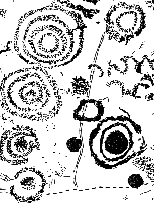 The first stories told of our place
in society and culture through elaborate genealogical inventories. Repetitive
structures built into the frame work of such stories acted as navigational aids
to locate one's sense of place within the temporal unfolding of the narrative
line. A cycle of stories and the rituals built around them, functioned as a
metaphorical model for how reality was believed to work: a map powered by a
tradition of commonly held beliefs, by which one could measure the events of
life's progress. Every human activity from birth to death, had externalized
ritualized representation of the internalized narrative of the society. The
stories were integrated in form and content to give the listener a plane of
reference within the workings of the perceived universe. Everyone was on the
same page. If the narrative was altered in any way, the image of the universe
would collapse and the society would be most certainly doomed.
The first stories told of our place
in society and culture through elaborate genealogical inventories. Repetitive
structures built into the frame work of such stories acted as navigational aids
to locate one's sense of place within the temporal unfolding of the narrative
line. A cycle of stories and the rituals built around them, functioned as a
metaphorical model for how reality was believed to work: a map powered by a
tradition of commonly held beliefs, by which one could measure the events of
life's progress. Every human activity from birth to death, had externalized
ritualized representation of the internalized narrative of the society. The
stories were integrated in form and content to give the listener a plane of
reference within the workings of the perceived universe. Everyone was on the
same page. If the narrative was altered in any way, the image of the universe
would collapse and the society would be most certainly doomed.
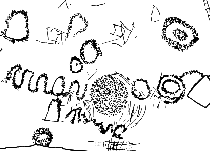 It is said that in many early and
oral tradition-based cultures, the poet was the most important member of the
community, since he or she knew all of the words, and all of the stories which
the words made, and therefore they knew the order in which the society existed.
In pre-Christian Ireland for example, the poet was in a social status right
next to the king. In battle, kings could be killed, but the killing of a poet, was considered to be
the worse sacrilege. Poets of opposing armies would often begin a battle by
flinging satires at each other. A gifted poet could blight crops, raise
blisters, and even kill with a single word.
It is said that in many early and
oral tradition-based cultures, the poet was the most important member of the
community, since he or she knew all of the words, and all of the stories which
the words made, and therefore they knew the order in which the society existed.
In pre-Christian Ireland for example, the poet was in a social status right
next to the king. In battle, kings could be killed, but the killing of a poet, was considered to be
the worse sacrilege. Poets of opposing armies would often begin a battle by
flinging satires at each other. A gifted poet could blight crops, raise
blisters, and even kill with a single word.
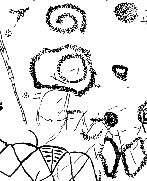 Such a poet knew the precise
etymology of every word and how to use words for the maximum effect. To attain
such a skill without depending upon writing systems, would require the
development of a prodigious memory skills through a long and rigorous
apprenticeship. The stories had to
be learned to be recited with complete and unfailing accuracy, with no room for
variations. In this regard, all the stories varied little over great periods of
time and were well-known by everyone within the society. It was the incantatory
retelling however, that was the ultimate sacred duty for a poet: a constant act
of artistic and priestly performance of speaking the words aloud and thereby
reinventing the order of all things through a sympathetic magic which expressed
the information that the society existed and believed in.
Such a poet knew the precise
etymology of every word and how to use words for the maximum effect. To attain
such a skill without depending upon writing systems, would require the
development of a prodigious memory skills through a long and rigorous
apprenticeship. The stories had to
be learned to be recited with complete and unfailing accuracy, with no room for
variations. In this regard, all the stories varied little over great periods of
time and were well-known by everyone within the society. It was the incantatory
retelling however, that was the ultimate sacred duty for a poet: a constant act
of artistic and priestly performance of speaking the words aloud and thereby
reinventing the order of all things through a sympathetic magic which expressed
the information that the society existed and believed in.
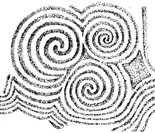 The indigenous people of Australia,
believe that their ancestors, sung the world into existence during their
travels in the Dream Time. Its continued existence is maintained by those on
walkabout singing the songlines. The traditions of a 40,000 year old culture
are transposed upon the geology of Australia, and the whole continent can be
sung like a musical score. Every rock and crack of the unrelentingly vast
outback has a song associated to it, and the traveler knows exactly their
location by their place along the songline. Any deviation in the accuracy of
the song would most assuredly bring death to the traveller and untold damage to
the world at large. Certainly, when one culture overpowers another, it is the
living memory of the story teller which is lost after a single generation.
The indigenous people of Australia,
believe that their ancestors, sung the world into existence during their
travels in the Dream Time. Its continued existence is maintained by those on
walkabout singing the songlines. The traditions of a 40,000 year old culture
are transposed upon the geology of Australia, and the whole continent can be
sung like a musical score. Every rock and crack of the unrelentingly vast
outback has a song associated to it, and the traveler knows exactly their
location by their place along the songline. Any deviation in the accuracy of
the song would most assuredly bring death to the traveller and untold damage to
the world at large. Certainly, when one culture overpowers another, it is the
living memory of the story teller which is lost after a single generation.
Some books on these subjects include:
Technicians of the Sacred, edited by Jerome Rothenberg (New York: Doubleday Anchor, 1972). The classic anthology of ethnopoetry.
Shaking the Pumpkin, edited by Jerome Rothenberg (New York: Doubleday Anchor, 1972). The traditional poetry of the Indian North Americans with an emphasis upon the non-semantic and connections with contemporary work.
Reading the Country, by Krim Benterrak, Stephen Muecke, and Paddy Roe (Freemantle, Australia: Freemantle Arts Centre Press, 1984). A collaboration between an Aboriginal poet/story-teller, a European taught anthropologist, and a Parisian-trained, Marrakech-born painter, to "read" an area of the Western Australian landscape.
The Songlines, by Bruce Chatwin (Great Britain: Jonathan Cape, Ltd, 1987). The classic travelogue as poetry.
All images from passage-grave art in the Boyne valley, by Claire O'Kelly (Cork, Ireland: Claire O'Kelley, 1973).